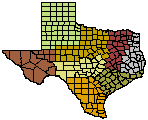- Trans Pecos
- High Plains/Panhandle
- Cross Timbers
- Hill Country
- Post Oak Savannah
- Pineywoods
- Oak Prairie
- South Texas Plains

Wildlife Division District Map
Livestock Management
Livestock management operations are the single most important factor that effect wildlife populations in the Post Oak Savannah and Blackland Prairie regions. Fortunately wildlife and cattle management are compatible and easily integrated.
Livestock should be stocked at the NRCS (formerly SCS) recommended rate, or at a rate determined from vegetative sampling in a comprehensive grazing plan. As a general rule, moderate to light stocking rates for well-managed pastures in this area are: one animal unit (cow with calf) per 8 - 15 acres on native grass; 3 - 6 acres on tame pastures (bermudagrass/bahia grass); 50 - 75 acres on wooded areas. These recommended stocking rates are general in nature and can vary depending on current range and soil conditions. Therefore, developing a grazing plan specific to the local range and soil conditions will greatly enhance livestock production and improve or maintain suitable wildlife habitat.
Rotational Grazing: Rotating livestock through multiple pastures will allow each pasture a sufficient period of rest between grazing periods, will greatly improve pasture performance for livestock, and encourage the growth of important seed producing grasses and forbs for wildlife. Rotational grazing also maintains a certain amount grass and forb cover important to ground nesting birds and young fawns. Some methods of rational grazing are listed below
Two pasture system- Graze first pasture 3 months. Graze second pasture 6
months. Graze first pasture 6 months. Graze second pasture 3 months.
Three pasture one herd system- Rotate livestock every 3 months. This allows
each pasture to receive 6 months of rest before being grazed again. Over
a period of several years, pastures received rest during different seasons.
Four pasture three herd- Three herds of livestock in three of the four pastures.
One herd is moved every 4 months. This allows for a pasture to be grazed
for 1 year and rested 4 months.
Four pasture one herd system- Graze a pasture 2 months and then move livestock
to adjacent pasture.
HILF System (High intensity and low frequency) - A relatively high number
of cattle (high intensity) are grazed through multiple pastures, and each
pasture is allowed long periods of rest (low frequency).
Regardless of the system used, the object is the same, each pasture should be rested for at least as long as it is grazed, or longer, and no pasture should be grazed during the same season in consecutive years. This will allow the pastures to gradually improve for cattle, deer, and upland game birds.
Remember, a grazing system will fail if the range is overstocked with livestock. Therefore, the development of a comprehensive grazing plan that matches grazing intensity with available forage is highly recommended. Deer and exotic species need to be considered in the stocking as well as livestock.
Excluding cattle from wooded areas: Broadleaf plants, commonly called forbs or weeds, are the most important food items in the diet of many wildlife species, especially deer. However, they are seasonal and not always available. Deer become more dependent on browse (leaves and stems of trees and shrubs such as greenbriar, rattan vine, hackberry, elm and oak) as forbs decrease in availability. Browse species are not as high in protein but they are available on a year round basis. Therefore, they play an important role in the deer’s diet.
Cattle utilize many of the browse species that deer prefer. This competition can be reduced by fencing off wooded areas, especially bottomlands, to exclude cattle during times of the year when available forage is lacking (stress periods). The most important stress periods for the Post Oak Savannah and Blackland Prairie regions occur typically from June - August and January - February.
If possible, plan rotation schedules so cattle are excluded
from wooded tracts, especially bottomlands beginning in late August (when
fruits on American beautyberry begin to ripen) on through February. This
will eliminate the competition between deer and cattle for American beautyberry
and other browse and forb species - greenbriar, elm, hackberry, yaupon,
rattanvine, grape, tickseed clover, St. Andrews cross, cross-vine, Virginia
creeper, etc. Conversely, livestock can be rotated through woodlands outside
of the stress periods to utilize shade tolerant grasses, such as Virginia
wild rye, and control rank understory vegetation. Rotaing livestock through
woodlands in this manner is especially beneficial in stands that are kept
thinned. However, allowing livestock to graze in woodlands should be used
cautiously and cattle should kept out during periods where there may be
direct competition between cattle and deer for food.
Livestock Management
